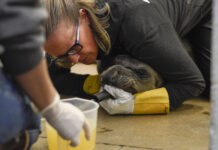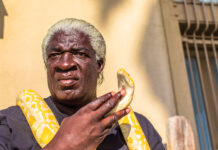Imagine yourself at a young age, enjoying life. You hear everyday things, from the Sunday morning cartoons to the melodic tunes coming from the radio during drives with your parents.
Then a strange fever makes you weak and sick. You go to the doctor to get shots, hoping for a cure. It gets even worse. Soon, all you hear is nothing.
Ahmed Elembaby is that person.
Born in Egypt, 26-year-old Elembaby was a toddler when he lost his hearing.
It was a struggle for his parents because they did not know sign language. Elembaby does not recall the transition to becoming deaf because he was so young. His elementary school teachers taught him a few signs so he could communicate with his parents. The older he got, the more he and his parents learned to sign. Then, Elembaby heard about the cochlear implant. He discussed it with his family and finally decided against it.
Instead, he made a choice to remain part of the deaf community.
“Surgeries to hear are being disrespectful to the deaf culture,” Elembaby says.
Now, Elembaby attends Los Angeles Pierce College, which has a renowned program in sign language.
Kristine Hall, who teaches American Sign Language at the school, is here for him and other students, helping them succeed.
Hall was born deaf, as were her parents, and she assumes it is a genetic trait.
She is proud to be deaf and says when her parents found she was born deaf, they were happy.
Hall’s parents worked for the California School for the Deaf, Fremont. She went to Gallaudet University in Washington D.C., the only deaf university in the world. Her parents wanted her to be a teacher, but she chose a different career path, studying communication arts.
After moving to Los Angeles, Hall worked as a teacher’s aid. The real teacher would take time off, so she took over and started teaching. Hall taught at an occupational center, where most of the students are foreign born, and she taught them ASL.
That is when she heard about an opening at Pierce. Hall was inspired to join the school’s faculty because she believed she could help deaf students on campus who need guidance.
Hall teaches ASL 40, Introduction to Deaf Culture and different levels of ASL. She also is responsible for running the Interpreter Education Program.
She faces the same struggles that all teachers do. Most of her daily life outside of school is similar to someone who can hear.
For example, Hall drives to work.
“Deaf people are better drivers than hearing people who are busy worrying what is on the radio,” she says.
The differences come when she needs to interact to people who can hear and don’t know how to sign. She deals with that simply, by asking them to write messages.
At home, her family uses sign language. Hall’s husband is deaf. Her two children are hearing, but they sign because that was the first language they learned.
When she first gave birth, she recalled asking the doctor to test if her child could hear. The doctor replied, “Your baby is normal.” She responded, “Are you saying I’m not normal?”
Hall continues to fight the normal stereotype by educating students about the complexities and beauty of her language.
One of Hall’s students is Valentine Feldstedt, an 18-year-old student who can hear. She says she appreciates Hall and the other advisers because they are helpful, and they don’t judge what you know or do not know about the deaf society.
What inspired Feldstedt to take ASL classes was her sixth grade friend who was going to lose her hearing before turning 16. Feldstedt’s friend taught her the alphabet in sign language, and Feldstedt later bought a book to learn even more.
Feldstedt wonders how it feels to be deaf, in part, because she is a singer, but through her ASL studies she has grown to appreciate the richness of the language.
“It’s more like story telling. It’s so theatrical and beautiful,“ Feldstedt says.
Whether it’s Elembaby, who hasn’t heard since his youth, or Feldstedt who learned ASL to better communicate with her friend, Hall and her colleagues strive to enrich the campus through a better understanding of all aspects of the deaf culture.



